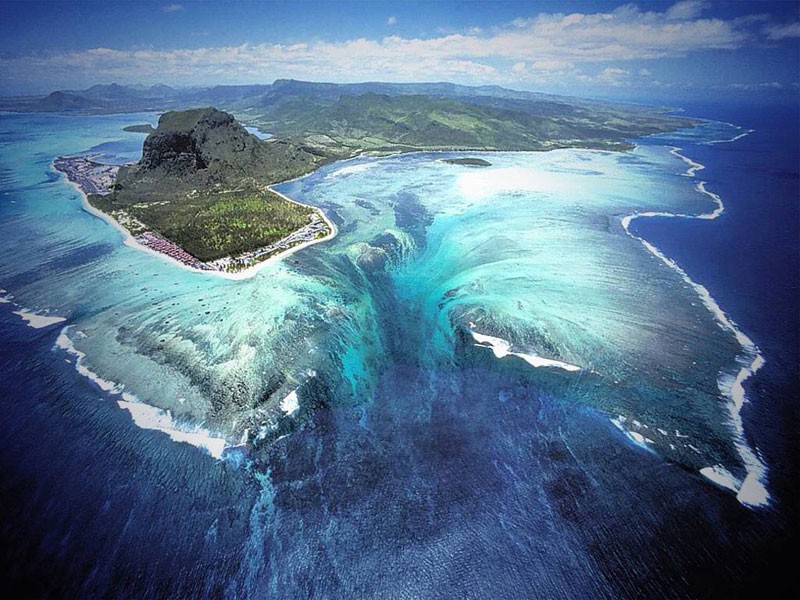The World’s Largest Waterfall Is Actually Underwater

Madagascar, situated in the Indian Ocean, is widely recognized, but 600 miles further east lies the much smaller island of Mauritius. Although Mauritius is only about 28 miles wide, it has a thriving population of 1.3 million and a bustling capital, Port Louis. However, one of the most fascinating natural phenomena occurs off the southwestern tip of the island: an optical illusion known as the “underwater waterfall.”
When viewed from above, especially during helicopter tours designed to showcase the spectacle, the ocean appears to be cascading downward, as though it is falling off a cliff into a massive abyss. This illusion is caused by the movement of sand and silt along the ocean floor. The water currents drag this material from the shallower waters surrounding the island into much deeper parts of the sea.
The stark contrast between the light turquoise waters of the shallow shelf and the deep blue of the surrounding ocean exaggerates this effect, making it appear as though an underwater waterfall exists. Though visually striking, it’s not a waterfall in the traditional sense, but a fascinating movement of sand and silt caused by natural ocean currents.

However, while Mauritius’ underwater illusion may attract tourists, the world’s actual largest waterfall isn’t visible to the naked eye and is found deep beneath the ocean’s surface. Located in the Denmark Strait between Greenland and Iceland, this giant waterfall is known as the Denmark Strait cataract. It is the world’s largest, most powerful, and tallest waterfall by far, though hidden beneath the waters.
The Denmark Strait cataract has a staggering flow rate of 5 million cubic meters of water per second and a drop of 3,500 meters—dwarfing even the famous Angel Falls in Venezuela, which drops 979 meters. What’s even more remarkable is that while Angel Falls is clearly visible, the Denmark Strait cataract is completely submerged and invisible without the use of specialized scientific instruments.
This incredible underwater waterfall forms due to the meeting of two ocean currents: the warm water of the Irminger Current, a branch of the Gulf Stream, and the frigid Greenland current. As the cold water from the Arctic moves south, it collides with the warmer current moving up from the equator. Cold water is denser and heavier than warm water, so it sinks below, creating a downward force as it is pushed into a massive underwater valley between Greenland and Iceland. This sinking cold water rushes down the slope at a tremendous rate, creating what can be classified as an underwater waterfall.
The unique topography of the Denmark Strait enhances this effect. The sea floor here has a dramatic drop-off, plunging 3,500 meters, which creates the conditions necessary for such an enormous underwater flow of water. The powerful forces that drive the Denmark Strait cataract are essential to the global ocean circulation system, known as the global conveyor belt.
This system plays a critical role in regulating the Earth’s climate by redistributing heat and cold around the planet. For example, the warm Gulf Stream that flows toward Europe helps keep countries like Norway and the United Kingdom much milder than other regions at similar latitudes.
This constant movement of warm and cold water helps balance temperatures worldwide, ensuring that cold regions are warmed while hotter areas are cooled. Though it’s impossible to witness this underwater giant firsthand, the Denmark Strait cataract’s unseen influence has far-reaching effects on the global climate, shaping weather patterns and maintaining Earth’s delicate balance.








